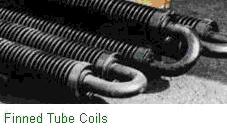 |
How
does tube side heat transfer
Coefficient affect selection of Fin Configuration? V.Ganapathy |
Tube
side heat transfer coefficient has an important influence on proper selection
of fin configuration in boiler superheaters,evaporators and economizers.Assuming
finned tubes may be used,a low fin density on the order of 1 to 2
fins/in (or low external surface area) is recommended when the tube
side heat transfer coefficient is low as in superheaters,while a high fin
density such as 4 to 6 fins/in may be used in evaporators and economizers;
of course we are assuming that the gas stream is clean and this aspect
is not influencing fin geometry selection.
Writing
the expression for overall heat transfer coefficient on tube inner diameter
basis(that makes comparison easy for any fin geometry) and neglecting the
effect of fouling factors and tube wall conductivity,we have:
1/Ui
= 1/hi + (Ai/At)/E ho
where
Ui=overall
heat transfer coefficient,tube ID basis,Btu/ft2hF
Ai,At
=tube internal and external surface areas,ft2
E=fin
effectiveness,fraction
ho=gas
side heat transfer coefficient,Btu/ft2hF
(Note
that UiAi=UoAt)
Example:
Study the effect of using 2 and 5 fins/in fin geometry on overall heat
transfer when tube side heat transfer coefficient varies: Use 2x.105 in
tubes,29 tubes/row,6 ft long,4 in square pitch,fin height=0.75 in,thickness=0.05
in serrated tubes;turbine exhaust gas flow=150,000 lb/h at 900 F.(surface
area of 2 fins/in tube=2.59 ft2/ft and 5fins/in tube=6.02 ft2/ft).
Using
the equations for finned tubes (see my books for example) or Chart
for finned tube heat transfer coefficient ,we compute ho and Ui for
varying hi values of 20,100 and 2000 Btu/ft2hF for both 2 and
5 fins/in options. The results are shown below.
Table
showing effect of inside coefficient on overall heat transfer coefficient
| hi,Btu/ft2hF |
20 |
20 |
100 |
100 |
2000 |
2000 |
| fins/in |
2 |
5 |
2 |
5 |
2 |
5 |
| G,lb/ft2h |
5591 |
6366 |
5591 |
6366 |
5591 |
6366 |
| Ai/(EhoAt) |
.01546 |
.00867 |
.01546 |
.00867 |
.01546 |
.00867 |
| Uo |
2.73 |
1.31 |
7.03 |
4.12 |
11.21 |
8.38 |
| Ui |
15.28 |
17.00 |
39.28 |
53.55 |
62.66 |
109 |
| ratio
Ui |
1. |
1.11 |
1 |
1.363 |
1 |
1.74 |
| ratio
gas pr drop |
1 |
1.6 |
1 |
1.3 |
1. |
1.02 |
(Please see my book "Steam plant calculations
manual",for detailed calculations and more examples)
Conclusions
1.As
the tube side coefficient increases,the ratio of Ui values(between 5 and
2 fins/in tubes) decreases.With hi=20,the Ui ratio is only 1.11. With a
hi=2000,the Ui ratio=1.74. What this means is that as hi decreases,the
benefit of adding more finned surface becomes less attractive. With 2.325
times the surface area(6.02/2.59-see above for surface areas of 2 and 5
fins/in tubes)we have only 1.11 fold improvement in Ui. With higher hi
of 2000,the increase is a decent 1.74.(because of fin effectiveness,we
lose a little and hence not getting the maximum of 2.325).This
is the reason we don't use fins in tubular air heaters,where both the gas
and air side heat transfer coefficients are on the same order,namely 10
to 15 Btu/ft2hF.Fins are attractive only when the tube side
coefficient is very large compared to gas side coefficient.
2.A
simple estimation of tube wall temperature can tell us that higher the
fin density,the higher the tube wall temperature.
For
hi=100,with 2 fins/in,Ui=39.28. With a gas temperature of 900 F and fluid
temperature of say 600 F,the heat flux inside the tube is qi = (900-600)x39.28
=11,784 Btu/ft2h.The temperature drop across the tube side film
(hi=100)=11,784/100=118 F.Hence the wall temperature (neglect fouling etc)
is about 600+118=718 F.
With
5 fins/in,Ui=53.55. qi=53.55x(900-600)=16,065. Tube wall temperature= 600+(16,065/100)=761
F. The increase is about 43 F. The fin tip
temperature will also be higher with higher tube wall temperature.
3.The
ratio of gas pressure drops between the 2 and 5 fins/in designs(after adjusting
for the effect of Ui and for same energy transfer values) increases as
the tube side coefficient reduces.It is 1.6 for hi=20 and 1.02 for hi=2000.That
is,when hi is smaller,it is prudent to use smaller fin surface geometry.
4.Similar
conclusions may be drawn when fouling factor inside the tubes is high
as discussed
in this article.
Hence
if one sees a boiler superheater with say 5 or 6 fins/in fin density,the
fin selection may be questioned. You may have a much larger surface area
than a 2 fins/in design but the tube wall,fin tip temperatures will be
running hotter (leading to higher grade tube/fin materials) and probably
higher gas pressure drop.You may be unnecessarily paying more $$ for a
poor design.Ask for an option with say 2 fins/in design.With economizers
and evaporators(where the tube side coefficient is very high),5 or even
say 6 fins/in may be used,though this may not be the optimum configuration.

V.Ganapathy's
Home Page(Books,Software,Papers on Boilers,HRSGs)
email Ganapathy


![]()